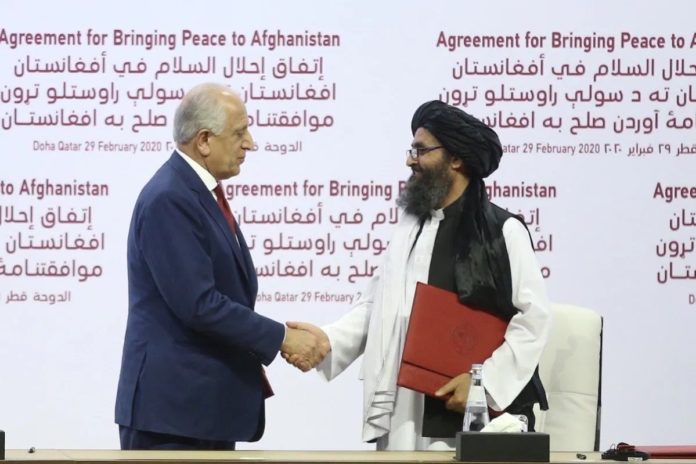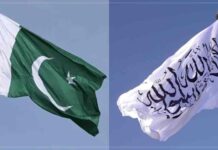New Delhi (NVI): On February 24, President Donald Trump declared in the presence of a huge gathering of nearly 1.24 lakh people in Ahmedabad that the US is a “trusted partner” of India.
Just five days later, his government signed a deal with Taliban, which carries the risk of causing serious security implications for India since the Afghan terror group has been inimical towards India and has been targeting Indian assets in Afghanistan.
The February 29 deal signed in Doha essentially provides a face-saver to the US for complete withdrawal from Afghanistan, within 14 months, after 19 years during which it suffered huge losses in terms of men and finances.
But the impact of the deal is apprehended to be serious, particularly considering the objectives of Taliban and the baggage of trust deficit it carries. Given the history of Taliban’s betrayals, it would be naive to believe in what it commits, even though it has not committed much in the agreement.
Living up to its reputation, the Taliban has already announced resumption of ‘operations’ against the government forces, ending a brief truce declared in the run up to the deal. In fact, one terror attack has already been carried out.
The mainstreaming of Taliban, effected by the deal, is expected to encourage the terror outfit to step up its military operations and attacks to dislodge the democratic set-up and decimate other Afghan factions.
Even during the presence of the US and other NATO forces, the militia, over the last several years, has been increasing its area of influence by capturing more parts of Afghanistan.
More the areas it brings under its fold, the more is the risk, particularly for India, considering the history and avowed intentions against India.
India, notwithstanding its presence at the deal-signing ceremony, has already articulated its unease, with External Affairs Minister S Jaishankar saying the US has been told that the gains made in the last 18 years should not be withered.
India’s concerns stem from that fact that the Taliban, during its rule from 1996 to 2001, and even afterwards, worked to hurt its interests, including through repeated terror attacks. Taliban also has close association with Lashkar-e-Taiba (LeT), which was, in fact, founded in Kuduz in Afghanistan.
Taliban, which is a proxy of Pakistan, has made it clear that India should have nothing to do in Afghanistan and should leave. India has more than 2 billion dollars of investment in Afghanistan and is engaged in capacity building of the local population through several programmes.
Afghanistan under Taliban was virtually a buffer area for Pakistan and its machinations to hurt India and its interests. After the exit of the US-led forces and possibly Taliban gaining more power, the same is feared to be repeated.
One may recall the hijack of Indian Airlines plane IC-814 to Kandahar in December 1999 by Pakistan-supported terrorists and the way Taliban frustrated India’s attempts to free the hostages is a stark reminder of its nefarious designs.
It is believed that after the aircraft landed in Kandahar, the Taliban provided the five hijackers with more weapons, including assault rifles, rather than making any effort to disarm them and free the hostages.
India’s repeated requests for sending its special forces to tackle the hostage situation was also denied, making it clear that it wanted no trouble for the hijackers.
Even after India released three dreaded terrorists in Kandahar in exchange for 166 hostages, the Taliban regime allowed them to travel all the way to Pakistan without any hindrance.
Following its ouster from government, the Taliban continued to target Indian assets and interests in Afghanistan. One of the major such strikes was the August 2008 suicide bomb attack at the Indian Embassy in Kabul, in which an Indian Brigadier and a senior IFS officer were among 60 people killed.
Another major incident was the terror attack on Indian Medical Mission in Kabul in February 2010, in which 6 Indians were killed.
It also targeted the men of Indian Border Roads Organisation engaged in constructing Zaranj-Delaram highway.
Besides, the Taliban repeatedly targeted Indian Consulates in Kandahar and Jalalabad.
While finalising the agreement, the US has made a lot of concessions as Trump’s only intent seemingly was to see how America could wriggle out of the never-ending war and its forces could return home.
Among other things, the agreement signed in Doha on February 29 says, “…Taliban will not allow any of its members, other individuals or groups, including al-Qa’ida, to use the soil of Afghanistan to threaten the security of the United States and its allies.”
In the pact, the US has made a promise to work for lifting of sanctions on the Taliban members and engage with other members of the UN Security Council with the purpose of doing so by August 27 this year.
In the agreement, the Taliban also extracted a promise from the US that its 5,000 fighters would be freed from prisons by the Afghan government. It is a different matter that that the Ashraf Ghani government is not willing to implement this.
The deal also says that the US and Taliban “seek positive relations with each other and expect that the relations between the United States and the new post-settlement Afghan Islamic government as determined by the intra-Afghan dialogue and negotiations will be positive.”
This was unthinkable till a couple of years back as the US had set out to eliminate Taliban for harbouring and associating with Al Qaida, which carried out the unprecedented terror attacks on World Trade Centre and three other places in America on September 11, 2001.
Being a major political issue in the US, the return home of the American troops from the longest ever war in the US history marks fulfilment of a poll promise made by Trump, who is seeking re-election this November.
Trump’s predecessor Barack Obama also had worked in this direction by substantially reducing the presence of American troops in Afghanistan, but the current US President’s move entails complete withdrawal.
The US troops, along with NATO allies, invaded Afghanistan in October 2001 under ‘Operation Enduring Freedom’ launched against Al Qaida and Taliban, which was then ruling the country and providing safe haven to Al Qaida.
While targeting Al Qaida, the US-led forces went after Taliban and succeeded in ousting it from power by December 17. However, the top terrorist leaders, including Al Qaida chief Osama bin Laden and Taliban chief Mullah Omar remained elusive during the intense military campaign of the US-led forces.
Laden was later tracked and hunted down by the Americans in Abbottabad in Pakistan in 2013. Omar was also declared killed in 2015.
The Taliban (meaning ‘students in Urdu and Pashto) was formed by Pakistan in early 1990s from among the Afghan refugees in madrassas after the USSR left Afghanistan and various factions were fighting to control Kabul.
The big militia groups were Northern Alliance led by Ahmad Shah Masood, Hizb-e-Islami led by Gulbadin Hekmatyar and one led by Uzbek warlord Abdul Rashid Dostum.
Pakistan, particularly its notorious intelligence agency ISI, provided Islamic indoctrination, weapons, training and guidance to the Taliban cadres and pushed them into the war in Afghanistan.
By September 1996, the Taliban captured Kabul by dislodging President Burhanuddin Rabbani’s government and two years later, it expanded its control to about 90 per cent of Afghanistan.
It was a brutal regime, which enforced severe Sharia rules under which men were required to grow beard and women had to be all-covered with burqa. The regime also indulged in severe punishments like public executions and banned all modes of entertainment, such as TV, music and cinema.
Girls were barred from going to school.
In 2001, regime destroyed the famous Bamiyan Buddha statues in central Afghanistan.
And if the deal results in Taliban returning to power in Kabul or capturing it, the same brutalities will be back, which is a sad prospect for the people of Afghanistan.








